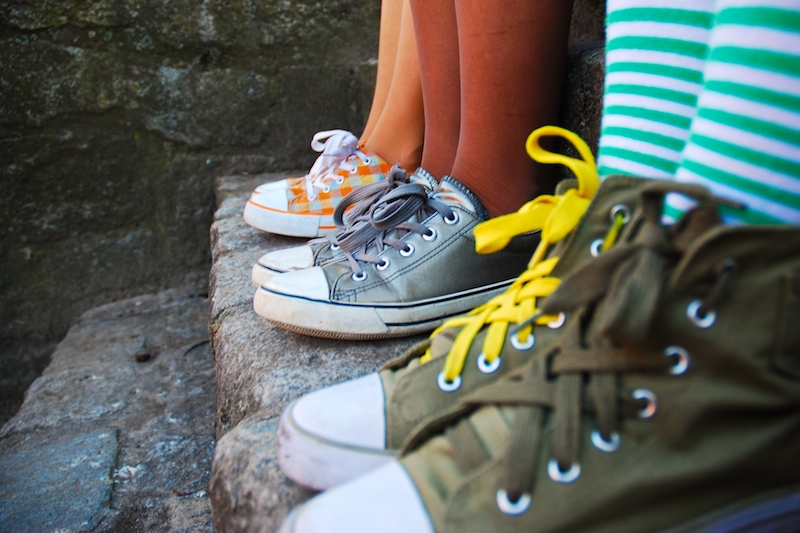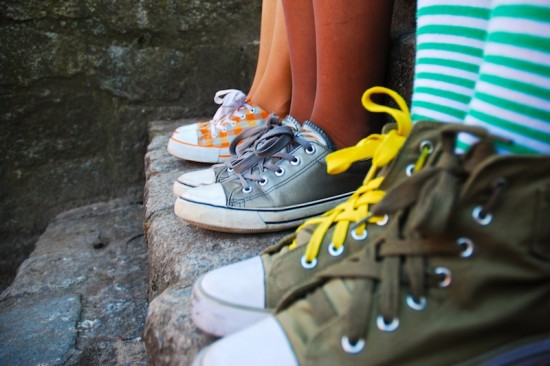Helping Kids Make Friends: What the Research Says
Piles of journal articles. That’s the phrase that best describes my living room coffee table right now. PILES, people.
I HAVE been hoarding research on friendship for years. And lately I’ve been sifting through it in force.
So these articles, these books, these dissertations that cover every square inch of my coffee table? They represent society’s best insights on connectivity and friendship so far. And it’s from this, as well as reader feedback, that I’ll be crafting many of the questions asked in my upcoming interviews. [Willing to let me interview you? Leave a comment on last week’s post.]
Today, I thought I’d summarize some of the existing research about how we move toward (or away from) friendship during the span of our lives.
We’ll begin with what friendship typically looks like in childhood.
Our First Moves Toward Connecting
- A human being’s first intimate relationship is with his or her mother. Breast-feeding and other care-giving acts often provide bonding (McAdams, 1989, p. 139).
- Interactions between the young child and the mom form behavior patterns that surface in later relationships (Bowlby and Ainsworth, 1991).
- If the caregiver is sensitive and responsive, it may help the child develop a secure attachment style (Rothbard and Shaver, 1994).
- Secure parent-child relationships lead to positive friendships while negative parent-child relationships lead to less positive and less connected friendships (Youngblade and Belsky, 1992).
- This mother-child bond serves as a prototype for warm and close relationships to follow. Those with positive mother attachments are seen to be more popular and competent (McAdams, 1989, pp. 140-143).
- Three ways parents influence children’s later friendships are 1) interacting with them; 2) supervising, coaching, and advising play; and 3) providing social opportunities (McCollum and Ostrosky).
How Things Start to Develop
- Youth under 10 may not be able to relate to each other on a personal basis which is generally a requirement for ongoing friendship. Even so, younger children still have “friendship experiences” in less sophisticated ways, beginning around age three (Howes, 1996; Rose and Asher 2000).
- In 1992, William K. Rawlins described friends between three to six year olds as “momentary physicalistic playmates.” Kids at this age respond to age-mates and enjoy playing together as long as they are participating in the same activity.
- Rawlins (1992) suggests six to nine year olds form friendships because they live close to each other, are the same sex or age, or have the same social maturity. They do physical activities, make believe, and chase adventures like their heroes. They often believe their friends must share all of their ideas and opinions.
- This agreement between child friends seems to confirm how right their own views are, providing consensual validation (Harry Stack Sullivan, 1953).
- According to Rawlins, less sameness is required between nine and twelve years old. In this stage, kids begin to respond to each other’s attitudes, beliefs, and values. They begin to be able to take in the perspective of others.
Next week, we’ll talk about how friendship tends to develop in adolescence and adulthood, but in the mean time feel free to leave a comment telling me how your experience DOES or DOESN’T fit with the bullet points above. And as always, I’d love to hear what you’re wondering about friendship lately. Knowing what you are curious about will help me shape the best research questions.



Cathy B October 8, 2014 (6:51 pm)
I have never read anything about child development before but I thought it was so interesting that kids identify with people who are like them. I wonder how much of this carries over into later life as people stick with their own race, etc. I think this would be an interesting question for you to raise in your interviews.
Sarah October 8, 2014 (10:00 pm)
I agree that the way we group should be a focus. Thanks for adding that!